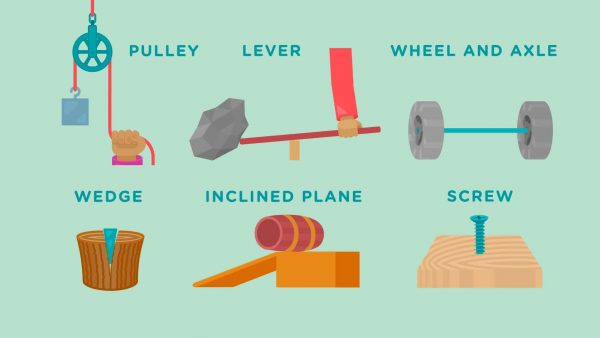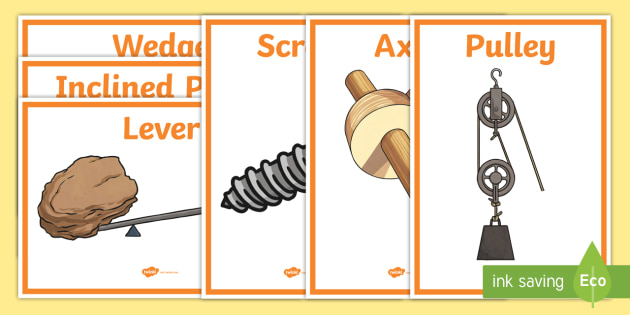Simple Machines and How They Work
Exploring Simple Machines and Their Functions
Unveiling the Secrets of Basic Mechanical Marvels
Simple machines, the unsung heroes of mechanics, quietly revolutionize the way we manipulate motion and force to accomplish tasks. These unassuming devices, with minimal or no moving parts, serve as the building blocks of more complex mechanisms, amplifying power and making work more manageable. In this comprehensive guide, we'll delve into various types of simple machines, unraveling the mysteries of their functionality and exploring their diverse applications.
Demystifying the Concept of Simple Machines
A machine, in essence, is a contrivance that performs work by applying force over a distance. Simple machines excel at exerting force against a single load in a manner that enhances output force by reducing the distance the load travels. The ratio between output force and applied force defines the mechanical advantage of a machine.
Understanding the Inner Workings of Simple Machines
The operational principle of simple machines revolves around altering the direction or magnitude of a force. Essentially, a simple machine relies on one or more of the following strategies:
- Changing the Direction of a Force: Simple machines redirect the force applied.
- Amplifying the Magnitude of a Force: These machines increase the force applied.
- Transferring Force from One Location to Another: Simple machines facilitate the transfer of force.
- Augmenting the Speed or Distance of a Force: These machines enhance the speed or distance of the force applied.
The Six Archetypes of Simple Machines
Let's explore the six fundamental types of simple machines: the wheel and axle, lever, inclined plane, block and tackle, screw, and wedge.
1. Wheel and Axle
The wheel and axle streamline the transportation of heavy loads and aid in covering distances efficiently. With a small footprint, a wheel reduces friction when moving an object across a surface. Furthermore, a wheel and axle act as a force multiplier, where the input force rotates the wheel, generating significant torque or rotational force at the axle. A long handle attached to an axle achieves a comparable effect.
2. Lever
A lever establishes a balance between force and distance. A seesaw is a familiar example of this type of simple machine. Featuring a long beam and a pivot or fulcrum, a lever, depending on the placement of the fulcrum, allows you to either lift a heavy load over a shorter distance than the input force or lift a lighter load over a greater distance than the input force.
3. Inclined Plane
An inclined plane manifests as a ramp or an angled surface, increasing the distance over which a force acts. It aids in lifting loads too heavy to elevate vertically. However, the steeper the incline, the more effort required. Climbing a steep ramp demands more energy than ascending a gentle slope.
4. Block and Tackle
A block and tackle either alters the direction of a force or trades increased force for reduced distance. For instance, lifting a bucket of water straight from a well necessitates considerable force. By employing a block and tackle, you can pull it up with less effort, albeit over a more extended distance.
In conclusion, simple machines, with their ingenious designs, empower us to overcome physical limitations and accomplish tasks with greater efficiency. As we unravel the intricacies of these mechanical marvels, we gain a deeper appreciation for the role they play in simplifying our daily lives.
5. Screw
The screw, a versatile and ubiquitous simple machine, converts rotational motion into linear motion. This helical structure allows for effective penetration into materials, securing objects together or lifting loads. A screw's threads create a mechanical advantage, requiring less force to accomplish tasks such as fastening or lifting.
6. Wedge
A wedge, with its triangular shape, excels at separating objects or holding them in place. Whether splitting wood with an axe or securing a doorstop, a wedge utilizes its tapered form to amplify the force applied. This simple machine proves invaluable in various applications, showcasing its ability to make challenging tasks more manageable.
Applications of Simple Machines
Understanding the applications of these simple machines is crucial for appreciating their significance in everyday life.
Enhancing Transportation with the Wheel and Axle
The wheel and axle revolutionize the movement of goods and people, reducing friction and facilitating smooth transport over various surfaces. From the earliest carts to modern vehicles, the wheel and axle remain integral to efficient transportation.
Streamlining Lifting Operations with the Lever
Levers play a pivotal role in lifting heavy loads with minimal effort. Whether in construction, manufacturing, or daily activities, levers enhance our ability to move objects efficiently.
Facilitating Elevation with the Inclined Plane
Inclined planes, in the form of ramps, simplify the process of elevating objects. They find application in wheelchair ramps, loading docks, and other scenarios where lifting vertically would be impractical or strenuous.
Simplifying Hoisting Tasks with Block and Tackle
The block and tackle mechanism eases the burden of hoisting heavy loads. It's a common sight in construction sites, aiding in activities such as raising building materials to elevated levels.
Securing Joints with the Screw
Screws, with their threading mechanism, secure objects together. From assembling furniture to constructing structures, screws are ubiquitous in creating stable and durable connections.
Managing Force with the Wedge
Wedges are indispensable in tasks requiring forceful separation or fixation. From carpentry to industrial applications, wedges play a vital role in ensuring stability and precision.
Simple machines, often overlooked in their simplicity, form the backbone of mechanical efficiency. As we navigate through the intricacies of the wheel and axle, lever, inclined plane, block and tackle, screw, and wedge, it becomes evident that these unassuming devices are the unsung heroes that enable us to overcome physical challenges effortlessly. Embracing the brilliance of simple machines enhances our understanding of the world around us, revealing the elegance hidden within their straightforward designs.
Simple machines, the unsung heroes of daily life, quietly assist us in performing tasks effortlessly. From the basic lever to the intricate screw, these ingenious devices have been shaping the world around us for centuries.
Types of Simple Machines
The Lever
Leverage your knowledge with an exploration of levers, ranging from first-class levers used in seesaws to third-class levers employed in human limbs.
The Inclined Plane
Discover how inclined planes make lifting heavy loads a walk in the park, illustrating their role in making our lives easier.
The Wheel and Axle
Roll into the mechanics of the wheel and axle, understanding their integral role in transportation and machinery.
The Pulley
Pull the curtain back on pulleys, unraveling the mysteries of their use in elevators and other lifting systems.
The Wedge
Wedge your way into the practical applications of wedges, from cutting tools to holding doors ajar.
The Screw
Screw in the details about screws, delving into their ubiquitous presence in construction and manufacturing.
How Simple Machines Work
Understanding the mechanical advantage of these devices is like deciphering a hidden code. Dive into the world of input and output forces, where friction plays a crucial role.
Real-World Applications
Explore the everyday gadgets and historical marvels that owe their existence to simple machines, showcasing their lasting impact.
Benefits and Limitations
While simple machines offer advantages like efficiency, they are not without constraints. Unearth the pros and cons that define their utility.
DIY Projects and Experiments
Embark on a journey of hands-on experiences with simple machine projects, making learning a dynamic and engaging process.
Impact on Technology
Witness the influence of simple machines on modern innovations and the seamless integration into the intricate machinery that defines our era.
Teaching Simple Machines
Uncover the importance of incorporating simple machines into science education, with interactive activities fostering a deeper understanding.
Sustainability and Simple Machines
Examine the role of simple machines in green technology, contributing to environmentally friendly solutions and reducing our carbon footprint.
Future Trends and Innovations
Peer into the crystal ball of technological advancements, exploring emerging technologies rooted in the principles of simple machines.
Conclusion
As we wrap up our journey through the realm of simple machines, it's clear that these unassuming devices are the building blocks of innovation, past, present, and future.
FAQs
- Are all machines considered simple machines?
- No, while many machines incorporate simple machine elements, not all machines fall under the category of simple machines.
- Can simple machines operate without friction?
- While it's ideal to minimize friction, some level of friction is inevitable in real-world applications of simple machines.
- How do simple machines contribute to sustainability?
- Simple machines play a role in sustainable practices by enabling efficient designs that reduce energy consumption.
- What is the difference between mechanical advantage and efficiency in simple machines?
- Mechanical advantage is a measure of force amplification, while efficiency considers the ratio of output to input work.
- Can simple machines be used in high-tech industries?
- Absolutely, simple machines serve as fundamental components in various high-tech industries, contributing to sophisticated machinery.





Comments
Post a Comment